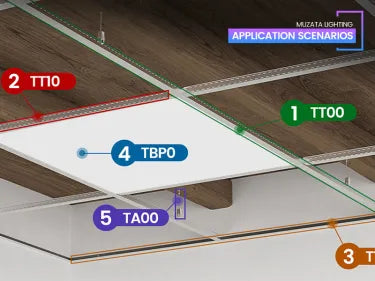TABLE OF CONTENTS
Do I Need LED Strip Channel?
LED strip lighting has become increasingly popular over the years due to its energy efficiency, versatility, and cost-effectiveness. It can be used in a variety of settings, including homes, offices, restaurants, retail stores, and more. However, one aspect that is often overlooked when it comes to LED strip lighting is the importance of LED strip channels. LED strip channels are an essential part of LED strip lighting, providing a range of benefits that ensure optimal performance and longevity.
Benefits of LED Strip Channel
Enhances durability and lifespan of LED strip lights
One of the primary benefits of LED strip channels is that they help to enhance the durability and lifespan of LED strip lights. When LED strip lights are installed without a channel, they are more susceptible to damage from external factors such as moisture, dust, and debris. Over time, this damage can lead to reduced performance and even failure of the LED strip lights.
However, LED strip channels help to protect the LED strip lights by providing a barrier against external factors. LED strip channels are typically made from materials that are resistant to damage, including aluminum, plastic, and metal. They offer a layer of protection that helps to extend the lifespan of LED strip lights, ensuring that they continue to perform optimally for years to come.
Provides a better lighting experience
Another benefit of LED strip channels is that they provide a better lighting experience. When LED strip lights are installed without a channel, the light emitted can often be uneven and harsh, leading to an unappealing and uncomfortable lighting experience. However, when LED strip lights are installed with a channel, the light emitted is diffused, creating a softer and more even lighting effect.
In addition, LED strip channels can also help to control the direction of the light, ensuring that it is focused where it is needed most. This can be particularly useful in settings such as kitchens, where under-cabinet lighting is used to illuminate workspaces. LED strip channels ensure that the light is directed downwards, providing optimal lighting for food preparation and other tasks.
Ensures safety
Finally, LED strip channels also provide an important safety benefit. When LED strip lights are installed without a channel, they can become a trip hazard, particularly in areas with high foot traffic. This can be dangerous, particularly in settings such as restaurants and retail stores, where customers and employees are constantly moving around.
However, LED strip channels help to eliminate this risk by providing a secure and stable mounting surface for LED strip lights. They ensure that the lights are firmly attached to the surface, reducing the risk of accidental dislodgement or falling.
Types of LED Strip Channels
There are several types of LED strip channels available, each with their own unique benefits and applications.
Surface-mounted channels
Surface-mounted channels are the most common type of LED strip channel, and are typically used for applications such as under-cabinet lighting and accent lighting. They are designed to be mounted directly onto the surface, and provide a clean and streamlined appearance.

Recessed channels
Recessed channels are another popular type of LED strip channel, and are typically used for applications such as cove lighting and stair lighting. They are designed to be mounted into the surface, creating a seamless and integrated lighting effect.

Angled channels
Angled channels are a more specialized type of LED strip channel, and are typically used for applications such as wall washing and display lighting. They are designed to be angled, allowing the light to be directed at a specific angle or position.
Factors to Consider When Choosing LED Strip Channels
When choosing LED strip channels, there are several factors to consider to ensure that you select the right channel for your specific needs.
Length and width of LED strip lights
One of the most important factors to consider when choosing LED strip channels is the length and width of the LED strip lights that will be installed. LED strip channels are typically designed to accommodate specific sizes of LED strip lights, and it is important to select a channel that is the correct size to ensure optimal fit and performance.
Material of the channel
Another important factor to consider when choosing LED strip channels is the material of the channel. LED strip channels are typically made from materials such as aluminum, plastic, and metal, and each material has its own unique benefits and drawbacks. For example, aluminum channels are lightweight and durable, while metal channels provide superior heat dissipation.

U-Shape LED Aluminum Channel System
Aesthetics of the channel
Finally, it is also important to consider the aesthetics of the LED strip channel. LED strip channels come in a range of styles and finishes, including black, white, and silver. It is important to select a channel that matches the overall design aesthetic of the space it will be installed in.
How to Install LED Strip Channels
Installing LED strip channels is a relatively simple process, and can be done with just a few basic tools.
Tools needed for installation
- LED strip channel
- LED strip lights
- Mounting clips or screws
- Drill
- Screwdriver
- Measuring tape
Step-by-step installation guide
-
Measure the length of the surface where the LED strip channel will be installed.
-
Cut the LED strip channel to size using a saw or a cutting tool.
-
Mark the mounting hole locations on the surface, using a pencil.
-
Drill holes into the surface at the marked locations.
-
Secure the LED strip channel to the surface using mounting clips or screws.
-
Insert the LED strip lights into the channel, ensuring that they are securely in place.
-
Connect the LED strip lights to a power source.
Tips and Tricks for Smooth Installation
-
Ensure that the surface where the LED strip channel will be installed is clean and free from debris, to ensure optimal adhesion.
-
Use a level to ensure that the LED strip channel is installed straight and level.
-
Allow adequate space between the LED strip lights and the channel, to prevent overheating and ensure optimal performance.
Conclusion
In conclusion, LED strip channels are an essential part of LED strip lighting, providing a range of benefits that ensure optimal performance, longevity, and safety. When choosing LED strip channels, it is important to consider factors such as the length and width of the LED strip lights, the material of the channel, and the aesthetics of the channel. With proper installation and maintenance, LED strip channels can help to enhance the overall lighting experience and ensure that LED strip lights continue to perform optimally for years to come.




